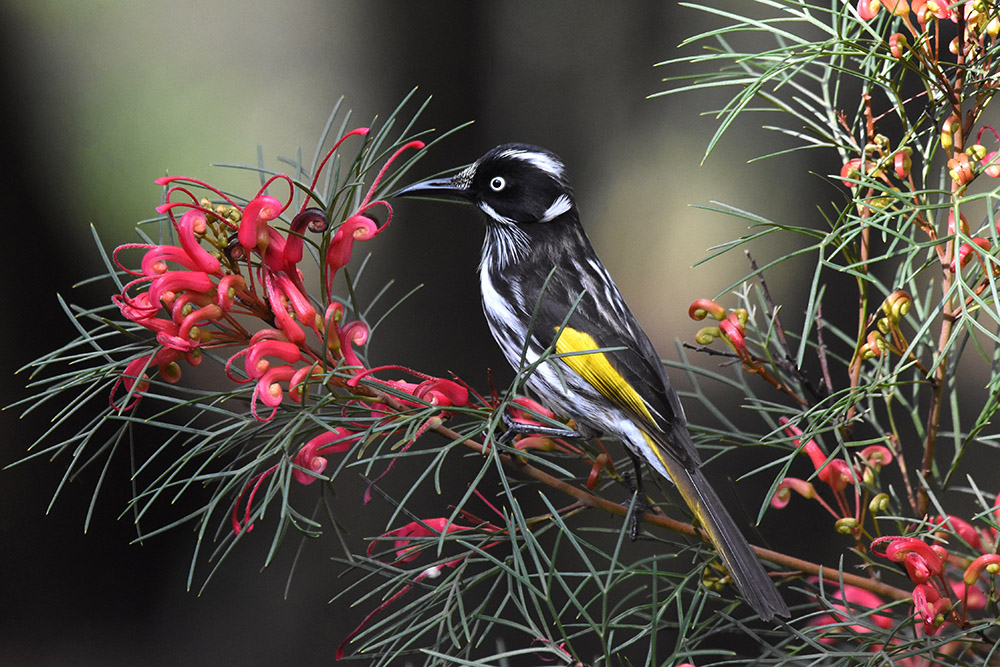May 2022 | Volume 23 No. 2
Sweet Deal for Songbirds
(Image courtesy of Gerald Allen, Macaulay Library)
We are all familiar with the ubiquitous image of a hummingbird hovering in front of a flower as it drinks the nectar but scientists only proved they could in fact taste sweet in 2014. Now a new study has shown that songbirds are also able to distinguish sweet tastes but they evolved this ability in different ways to the hummingbird.
“Many carnivorous animals do not have the ability to taste sweetness, and it was previously unclear if birds – which are descendants of meat-eating dinosaurs – could or not,” said Dr Simon Sin Yung-wa, Assistant Professor in the School of Biological Sciences and a member of the international team that did the research.
Cues for survival
It was important to find out because sensory systems evolve and adapt to allow animals to perceive cues important for survival. “The evolution of sensory receptors can affect the behaviours of a species and have profound ecological consequences,” said Dr Sin. “This may ultimately lead to speciation and adaptation radiation.”
“Birds are the most diversified terrestrial vertebrates, widely distributed on this planet and occupying different ecological niches,” he said. “The common ancestor of all birds, carnivorous dinosaurs, lost a subunit of the sweet taste receptor and hence the ability to taste sugar. However, we observed that many birds do eat sweet foods like nectar.”
They did know that some songbirds, like the sunbirds, consume a lot of nectar, but wanted to find out if all of them could taste sugar, and if so when this ability evolved. “The evolution of a new taste sense could have a big implication in the evolution and radiation in this group of birds, which includes almost half of the extant bird species,” said Dr Sin.
Twelve species of songbird were tested, including the warbling white-eye (Zosterops japonicus) which is a resident in Hong Kong and the carrion crow (Corvus corone) which, according to Dr Sin “was seen in Hong Kong but it’s only a vagrant”.
The leader of the research team, evolutionary biologist Dr Maude Baldwin from the Max Planck Institute for Ornithology, was the researcher who elucidated the evolution and mechanism of sweet perception in hummingbirds. Dr Sin was in the same laboratory as Dr Baldwin while they were at Harvard and he joined her in studying the evolution of taste perception in the songbirds.
“In hummingbirds, the umami receptor, which detects amino acids and is responsible for the savoury taste, evolved to become a sugar receptor,” said Dr Sin. “We found that songbirds are also able to taste sugar but we didn’t know how they are able to do that. Did their umami receptor also transform into a sweet receptor? If so, were the same or different mutations involved? Therefore, in this study we investigated the genetic basis and mechanism of sweet perception in the songbird to understand how different lineages of birds convergently evolved the same sensory ability.”

A New Holland honeyeater (Phylidonyris novaehollandiae) feeding on Wilson’s grevillea (Grevillea wilsonii), a favourite honeyeater food endemic to Western Australia.
(Image courtesy of Gerald Allen, Macaulay Library)
Generating chimera
Their methodology for identifying modifications to the umami taste receptor involved “a lot of experiments to generate chimera (for example between ancestral and current umami receptors) or introduce mutations to the receptors, and then test whether those receptors could be activated by sugar,” he explained. “By changing the composition of the umami receptors in this way we were able to identify the positions that are crucial for the transformation of the umami receptor to a sweet receptor.”
They found that although both hummingbirds and songbirds re-gained their sweet perception through mutations in the umami receptor, the changes in songbirds and hummingbirds coincide only slightly, even though similar areas of the receptor were modified. “These distant bird groups converged on the same solution of re-purposing their umami taste receptors to sense sugar over evolutionary time,” said Dr Sin. “However, each group modified the receptors in distinct ways to achieve the same outcome.”
The team was able to discover when this ability evolved by reconstructing the ancestral umami receptors at different locations on the songbird family tree, using the information of the umami receptors in extant species to test the receptor activity towards sugar. “It turns out that the early ancestors of songbirds evolved the ability to taste sugar, even before they radiated out of Australia [where most songbirds originated] and spread across the planet,” said Dr Sin. “We were very surprised by this result. While, in Australia, many different sugar sources are common, including insect secretions and tree sap, sugary food sources may have also helped songbirds spread to other continents and successfully occupy a variety of ecological niches.”
Distant bird groups converged on the same solution of re-purposing their umami taste receptors to sense sugar over evolutionary time. However, each group modified the receptors in distinct ways to achieve the same outcome.

DR SIMON SIN YUNG-WA

